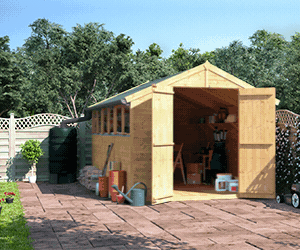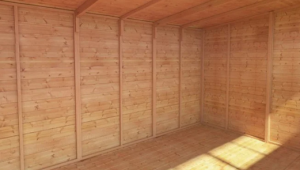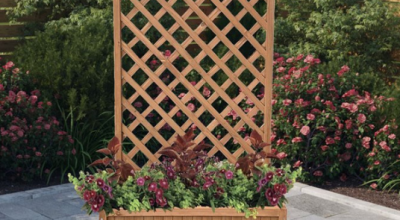Jump to:
One crucial aspect of plant care is knowing when and how to repot them. This applies to both novice and seasoned green thumbs. In this guide, we’ll walk you through the process, following the five simple steps. Ready to unearth the secrets to healthy root systems and vibrant growth? Keep reading!
Step 1: Gather Your Supplies

Gather the right supplies on your workbench (ideally in a potting shed), including:
- New pot: Choose a pot that accommodates growth. Also, ensure it has adequate drainage to prevent waterlogging.
- Fresh soil mix: Ensure a nutrient-rich blend suitable for your plant type. An all-purpose potting mix provides essential nutrients and good drainage. Cactus and succulent mix, in contrast, offer excellent drainage to prevent root rot. African violet mix is tailored for plants like African violets, promoting healthy growth.
- Trowel or spade: This handheld gardening tool features a flat, pointed metal blade. It’s designed for digging, lifting, and transferring soil. When repotting, it helps in gently removing the plant from its current container. Its use also helps manipulate the soil to accommodate the new pot.
- Pruning shears: Also known as secateurs, pruning shears are sharp, scissor-like tools. They are ideal for trimming excess roots and removing dead or damaged foliage.
- Gloves: Protect your hands from soil and potential irritants. Gardening gloves shield your hands from soil, thorns, and potential skin irritants. Wearing a pair ensures a comfortable and safe repotting experience.
- Watering can or spray bottle: Hydrate your plant post-repotting without overwhelming it. A watering can is a container with a spout and handle for controlled water pouring. A spray bottle typically has a trigger mechanism to disperse water in a fine mist. Both tools allow you to hydrate your plants precisely.
Each tool plays a crucial role in the repotting process. These essentials ensure your plant thrives in its new home.
Step 2: Choose the Right Pot
Selecting the right pot ensures your plant’s thriving environment. Consider these factors for a successful choice:
Pot selection
Common pot types for repotting include:
- Terracotta: Porous and excellent for plants that prefer well-draining soil.
- Plastic: Lightweight, affordable, and available in various sizes.
- Ceramic: Stylish and durable, ideal for plants that don’t mind moisture retention.
- Fibreglass: Lightweight yet sturdy, suitable for both indoor and outdoor use.
- Self-watering: Feature a reservoir for consistent moisture, which is great for busy plant parents.
- Hanging baskets: Perfect for trailing or vining plants, adding a decorative touch.
- Cache pots: Used as outer containers for plants in plastic pots, enhancing aesthetics.
- Fabric grow bags: Promote air pruning, preventing root circling and promoting robust growth.
- Wooden crates: Rustic containers for a charming, natural look.
Size matters
When choosing a new pot, opt for one that provides ample space for your plant’s roots to grow. A general rule is to select a pot that is 1-2 inches larger in diameter than the current one. This allows for sufficient room for root expansion without risking waterlogged soil.
Drainage is key
Ensure the chosen pot has drainage holes at the bottom. Proper drainage prevents water from accumulating, preventing root rot and other moisture-related issues. If you find a decorative pot without drainage, consider using it as a cache pot. Tip: Place your plant’s plastic nursery pot inside to allow excess water to escape.
Step 3: Prepare Your Plant

Preparing your plant for repotting involves delicate manoeuvres to ensure its health. Follow these quick and simple steps for a smooth transition:
Gentle extraction
Carefully tap the bottom and sides of the current pot to loosen the soil. Turn the pot upside down, supporting the base of the plant with your hand. Gently tap the pot’s rim or squeeze its sides to release the plant. If stubborn, slide a knife along the inner edges to loosen.
Root inspection and pruning
Once extracted, examine the roots for any signs of overcrowding, decay, or disease. Trim excessively long or damaged roots with clean pruning shears. Ensure the roots can comfortably fit in the new pot without tangling. If the plant is root-bound, gently tease the roots apart to encourage outward growth.
By handling these steps with care, you set the stage for the success of your plant repotting!
Step 4: Repotting Process

Navigate the repotting process seamlessly with this step-by-step guide:
Placing the plant
Gently position the plant in the centre of the new pot. Ensure its root ball sits at the same depth as in the previous container. Maintain the plant’s upright position, aligning it with the pot’s centre.
Filling with fresh soil
Surround the plant with a nutrient-rich, fresh soil mix. Leave an inch or two from the top to prevent overflow during watering. Pat the soil down gently to eliminate air pockets and provide stability.
Proper positioning
Confirm the plant is centred and upright. Adjust the soil level as needed. Ensure the crown (where stems meet the roots) sits just above the soil surface. This prevents issues like stem rot and promotes healthy growth.
By following these steps, you establish an optimal environment. Moreover, you encourage your plant to thrive in its new surroundings.
Step 5: Watering and Care After Repotting
Proper watering and care post-repotting are crucial for your plant’s adjustment. Follow these guidelines to nurture your green companion through the recovery period:
Watering instructions
After repotting, give your plant a thorough but gentle watering. Ensure the soil is evenly moist but not waterlogged. Allow any excess water to drain away, preventing the risk of root rot. Monitor the soil moisture consistently during the first few weeks. Adjust the watering frequency based on your plant’s specific needs.
Optimal care tips
- Limited sun exposure: Shield your plant from direct sunlight for a few days to reduce stress.
- Minimise disturbance: Avoid unnecessary handling or pruning during the recovery period.
- Monitor growth: Keep an eye on your plant’s progress. Observe for signs of new growth or potential issues.
Adhere to these care tips to provide the necessary support for your plant’s repotting.
Round-up
You now have the know-how to ensure your plants thrive. From choosing the right pot to caring for them after repotting, each step is crucial for their health. Enjoy watching your plants grow in their new homes. Remember that patience and care are the keys to success. Happy repotting, and may your plants flourish!
Enhance your repotting routine with the convenience of a BillyOh potting shed. Alternatively, consider maximising space by investing in a greenhouse available at BillyOh. Elevate the experience of plant caring with these dedicated and spacious structures!
Up next on your reading list: Potting Shed Ideas: Storage and Organisation Hacks













What do you think ?